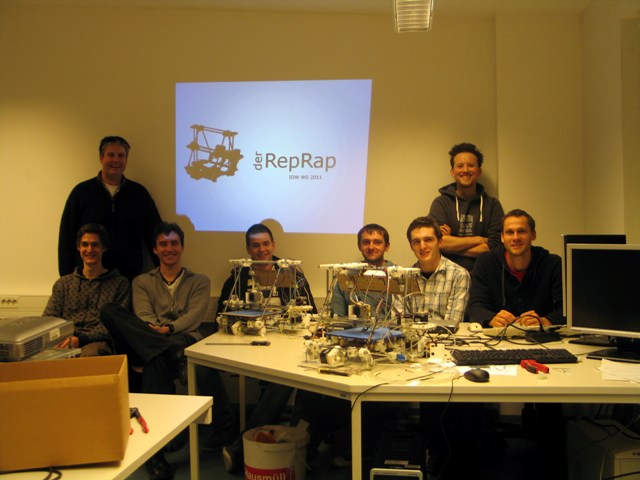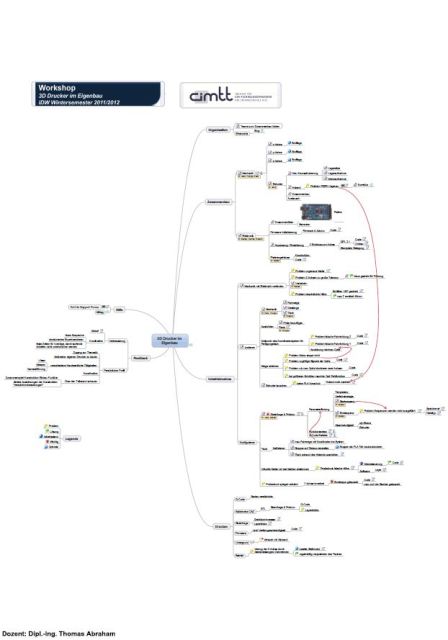Workshop: DIY 3D printer WS2011
9th day, 17th November 2011
Project completed!
The team is preparing the project presentation for the afternoon. Small remaining tasks on the 3D printer are completed.
During the presentation, each team member presents his focus. The recognised problems are explained and corresponding solutions presented. The carefully updated mindmap represents the whole project and can be ported easily with all relevant data and the project results.
Conclusion:
The project aim was achieved. Thanks to the numerous, different tasks that had to be completed while constructing the 3D printer, the team gained insights into various disciplines.
The workshop was evaluated very positively from all sides. All students saw the participations as a personal success.
8th day, 16th November 2011
Hooray, it is done!!
Already in the morning, the first layers were printed. The results are not very beautiful, but we can now start with the phase of optimisation.
The first problem is that the height of the component does not fit. The printed models are too small. After an intense problem analysis, we learnt that the scale of the Z axis has to be modified in the firmware of the printer.
After adjusting various printing parameters, especially the speed in the X/Y-area and the speed of extrusion, the results were better. In the evening, the group discussed extensions to the printing hardware. We discussed a cleaning station for the extruder, an additional second extruder and a much larger version of the printer.
Since the project is coming to an end, the following day was discussed. It is time to document the work results.
The printer is printing
Honey, it is a log
7th day, 15th November 2011
:-( :-( Not printed :-( :-(
Although the tasks of the day were manageable and the printer should have printed in the afternoon, it didn’t work out. The adjusting of the platform, construction of a necessary endflag and a construction mistake of the hot end adaption of the extruder took a lot of time.
The highlight of the day was a short visit by another IDW team of the Faculty of Multimedia Production that made a short film about our workshop.
The delay in the projects progress shows how practice-oriented this workshop is. There are always problem phases in small and large projects.
In the end of a long day, we managed to solve almost all problems and were able to extrude the material PLA from the printer.
Problems
Problems
Yes!!
6th Day, 14th November 2011
The week is starting with getting to know another Rapid Prototyping Technology, laser sintering and its specific work steps.
The work for the day is planned:
- fine adjusting of mechanical components.
- wise relocation of wiring.
- installation of the optimised extruder.
- adjusting the construction platform to the extruder.
- a housing for the electronic components.
The daily goal is the correct adjustment of all axes, endstops and the extruder.
We will print tomorrow . . . how exciting :-)
5th day, 11th November 2011
The team is tireless.
They decide: “The Z axes are flapping too much, that is not okay!”.
After a short brainstorming they decide: “the spindles of the Z axes must be turned and stored with bearings!”
According to the team slogan ‘Nothing is impossible’ the team members, who don’t have any experience with metal cutting, learn how to do so.
In conclusion, we can say that the task was solved masterfully and the team members grew into it.
The project status was monitored by a brainstorming tool and the mindmap is updated regularly. To give access to all team members, we use cloud technology.
4th day, 10th November 2011
The day begins with a brainstorming, to make decisions about the projects state. We use a professional brainstorming tool. Our result is a mindmap, where each work step will be recorded.
The day is characterised by the transition to a project routine. All previously assembled components of axes and extruder are combined and adjusted. This work step is very time-consuming and reveals weaknesses in the construction.
It is very pleasing that step motors, electronical components, firmware and control software are working together without any problem. The technical upgrades are a total success (2 endstops/axes).
The printer is placed upon an adjustable foot. The team is not discouraged by conventional technology :-). Simple aluminium angles are cut, bored and function perfectly.
3rd day, 9th November 2011
We are making progress!
The montage of the axes is nearly completed and we can install them tomorrow. Only the extruder is causing problems. The construction is again revealing weaknesses. They are so severe that we discuss a completely new construction.
The delivered hot end can’t be installed because the bore diameter seems to be too tight. Therefore, the group is making a digression into measurement technology, to carry out an incoming goods inspection.
Result: the component is drilled out.
The electronics team decides to extend the concept with 3 end stops (limit switches, that limit traverse), to limit the maximum of traverse. The ambitious plan requires a deep intervention in programming.
Shortly before the evening, the goal is completed. The minimum and maximum end stops are reacting. The extension of the concept is accomplished.
2nd day, 8th November 2011
Hooray, the delivery is here! We are excited!
To pass the time in a useful way, the group is organising a short CAD instruction, to teach those participants that have less experience with 3D CAD about the working procedure with such systems. The STL data that we need for the 3D printer are created and edited with the help of a CAD system.
After the arrival of the last missing data, the work can begin.
1st day, 7th November 2011
The first day of the workshop is shaped by introductions into the topics of rapid prototyping, the RepRap project and the work method of the CIMTT.
The group consists of 6 students from different faculties:
Thorge, International Sales and Purchasing in Engineering
Stefan, Mechanical Engineering
Felix, Computer Engineering and Internet
Roland, Naval Architecture and Maritime Engineering
Jens, Mechanical Engineering Master’s
Dennis, Electrical Engineering
This combination is especially delightful, because from an engineer’s perspective interdisciplinarity is given.
The students have identified the necessary works steps, determined their own strengths and discussed the work planning. On this basis, we have divided them in different groups, according to their identified focus areas.
For the next day, we have the unexpected difficulty that the delivery of the electronic construction components was delivered too late on Friday and could not be received. The new delivery date on Monday didn’t take place.
It remains exciting :-)







